Muyi Sun
DanceEditor: Towards Iterative Editable Music-driven Dance Generation with Open-Vocabulary Descriptions
Aug 24, 2025



Abstract:Generating coherent and diverse human dances from music signals has gained tremendous progress in animating virtual avatars. While existing methods support direct dance synthesis, they fail to recognize that enabling users to edit dance movements is far more practical in real-world choreography scenarios. Moreover, the lack of high-quality dance datasets incorporating iterative editing also limits addressing this challenge. To achieve this goal, we first construct DanceRemix, a large-scale multi-turn editable dance dataset comprising the prompt featuring over 25.3M dance frames and 84.5K pairs. In addition, we propose a novel framework for iterative and editable dance generation coherently aligned with given music signals, namely DanceEditor. Considering the dance motion should be both musical rhythmic and enable iterative editing by user descriptions, our framework is built upon a prediction-then-editing paradigm unifying multi-modal conditions. At the initial prediction stage, our framework improves the authority of generated results by directly modeling dance movements from tailored, aligned music. Moreover, at the subsequent iterative editing stages, we incorporate text descriptions as conditioning information to draw the editable results through a specifically designed Cross-modality Editing Module (CEM). Specifically, CEM adaptively integrates the initial prediction with music and text prompts as temporal motion cues to guide the synthesized sequences. Thereby, the results display music harmonics while preserving fine-grained semantic alignment with text descriptions. Extensive experiments demonstrate that our method outperforms the state-of-the-art models on our newly collected DanceRemix dataset. Code is available at https://lzvsdy.github.io/DanceEditor/.
ReMeREC: Relation-aware and Multi-entity Referring Expression Comprehension
Jul 22, 2025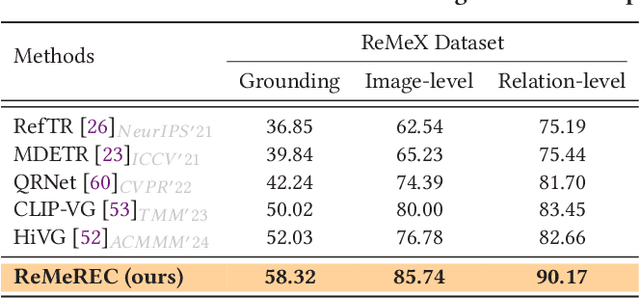
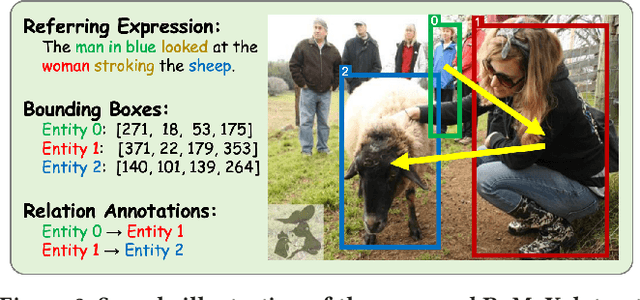
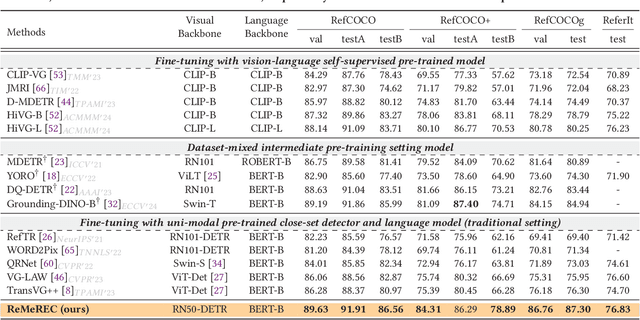
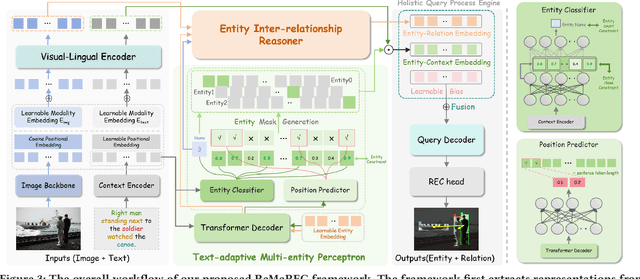
Abstract:Referring Expression Comprehension (REC) aims to localize specified entities or regions in an image based on natural language descriptions. While existing methods handle single-entity localization, they often ignore complex inter-entity relationships in multi-entity scenes, limiting their accuracy and reliability. Additionally, the lack of high-quality datasets with fine-grained, paired image-text-relation annotations hinders further progress. To address this challenge, we first construct a relation-aware, multi-entity REC dataset called ReMeX, which includes detailed relationship and textual annotations. We then propose ReMeREC, a novel framework that jointly leverages visual and textual cues to localize multiple entities while modeling their inter-relations. To address the semantic ambiguity caused by implicit entity boundaries in language, we introduce the Text-adaptive Multi-entity Perceptron (TMP), which dynamically infers both the quantity and span of entities from fine-grained textual cues, producing distinctive representations. Additionally, our Entity Inter-relationship Reasoner (EIR) enhances relational reasoning and global scene understanding. To further improve language comprehension for fine-grained prompts, we also construct a small-scale auxiliary dataset, EntityText, generated using large language models. Experiments on four benchmark datasets show that ReMeREC achieves state-of-the-art performance in multi-entity grounding and relation prediction, outperforming existing approaches by a large margin.
VividListener: Expressive and Controllable Listener Dynamics Modeling for Multi-Modal Responsive Interaction
Apr 30, 2025



Abstract:Generating responsive listener head dynamics with nuanced emotions and expressive reactions is crucial for practical dialogue modeling in various virtual avatar animations. Previous studies mainly focus on the direct short-term production of listener behavior. They overlook the fine-grained control over motion variations and emotional intensity, especially in long-sequence modeling. Moreover, the lack of long-term and large-scale paired speaker-listener corpora including head dynamics and fine-grained multi-modality annotations (e.g., text-based expression descriptions, emotional intensity) also limits the application of dialogue modeling.Therefore, we first newly collect a large-scale multi-turn dataset of 3D dyadic conversation containing more than 1.4M valid frames for multi-modal responsive interaction, dubbed ListenerX. Additionally, we propose VividListener, a novel framework enabling fine-grained, expressive and controllable listener dynamics modeling. This framework leverages multi-modal conditions as guiding principles for fostering coherent interactions between speakers and listeners.Specifically, we design the Responsive Interaction Module (RIM) to adaptively represent the multi-modal interactive embeddings. RIM ensures the listener dynamics achieve fine-grained semantic coordination with textual descriptions and adjustments, while preserving expressive reaction with speaker behavior. Meanwhile, we design the Emotional Intensity Tags (EIT) for emotion intensity editing with multi-modal information integration, applying to both text descriptions and listener motion amplitude.Extensive experiments conducted on our newly collected ListenerX dataset demonstrate that VividListener achieves state-of-the-art performance, realizing expressive and controllable listener dynamics.
PTM-VQA: Efficient Video Quality Assessment Leveraging Diverse PreTrained Models from the Wild
May 28, 2024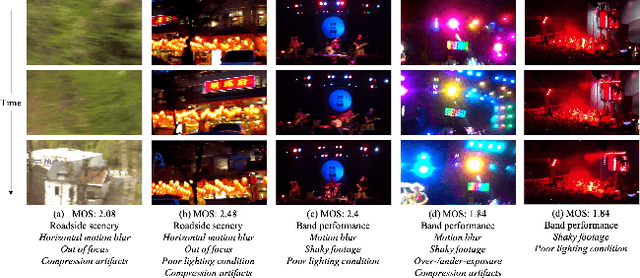

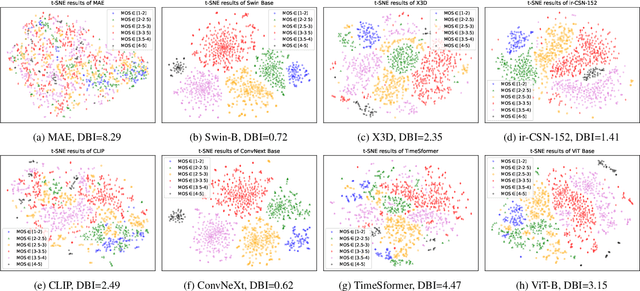

Abstract:Video quality assessment (VQA) is a challenging problem due to the numerous factors that can affect the perceptual quality of a video, \eg, content attractiveness, distortion type, motion pattern, and level. However, annotating the Mean opinion score (MOS) for videos is expensive and time-consuming, which limits the scale of VQA datasets, and poses a significant obstacle for deep learning-based methods. In this paper, we propose a VQA method named PTM-VQA, which leverages PreTrained Models to transfer knowledge from models pretrained on various pre-tasks, enabling benefits for VQA from different aspects. Specifically, we extract features of videos from different pretrained models with frozen weights and integrate them to generate representation. Since these models possess various fields of knowledge and are often trained with labels irrelevant to quality, we propose an Intra-Consistency and Inter-Divisibility (ICID) loss to impose constraints on features extracted by multiple pretrained models. The intra-consistency constraint ensures that features extracted by different pretrained models are in the same unified quality-aware latent space, while the inter-divisibility introduces pseudo clusters based on the annotation of samples and tries to separate features of samples from different clusters. Furthermore, with a constantly growing number of pretrained models, it is crucial to determine which models to use and how to use them. To address this problem, we propose an efficient scheme to select suitable candidates. Models with better clustering performance on VQA datasets are chosen to be our candidates. Extensive experiments demonstrate the effectiveness of the proposed method.
MoPE-CLIP: Structured Pruning for Efficient Vision-Language Models with Module-wise Pruning Error Metric
Mar 12, 2024Abstract:Vision-language pre-trained models have achieved impressive performance on various downstream tasks. However, their large model sizes hinder their utilization on platforms with limited computational resources. We find that directly using smaller pre-trained models and applying magnitude-based pruning on CLIP models leads to inflexibility and inferior performance. Recent efforts for VLP compression either adopt uni-modal compression metrics resulting in limited performance or involve costly mask-search processes with learnable masks. In this paper, we first propose the Module-wise Pruning Error (MoPE) metric, accurately assessing CLIP module importance by performance decline on cross-modal tasks. Using the MoPE metric, we introduce a unified pruning framework applicable to both pre-training and task-specific fine-tuning compression stages. For pre-training, MoPE-CLIP effectively leverages knowledge from the teacher model, significantly reducing pre-training costs while maintaining strong zero-shot capabilities. For fine-tuning, consecutive pruning from width to depth yields highly competitive task-specific models. Extensive experiments in two stages demonstrate the effectiveness of the MoPE metric, and MoPE-CLIP outperforms previous state-of-the-art VLP compression methods.
* 18 pages, 8 figures, Published in CVPR2024
Diverse 3D Hand Gesture Prediction from Body Dynamics by Bilateral Hand Disentanglement
Mar 21, 2023Abstract:Predicting natural and diverse 3D hand gestures from the upper body dynamics is a practical yet challenging task in virtual avatar creation. Previous works usually overlook the asymmetric motions between two hands and generate two hands in a holistic manner, leading to unnatural results. In this work, we introduce a novel bilateral hand disentanglement based two-stage 3D hand generation method to achieve natural and diverse 3D hand prediction from body dynamics. In the first stage, we intend to generate natural hand gestures by two hand-disentanglement branches. Considering the asymmetric gestures and motions of two hands, we introduce a Spatial-Residual Memory (SRM) module to model spatial interaction between the body and each hand by residual learning. To enhance the coordination of two hand motions wrt. body dynamics holistically, we then present a Temporal-Motion Memory (TMM) module. TMM can effectively model the temporal association between body dynamics and two hand motions. The second stage is built upon the insight that 3D hand predictions should be non-deterministic given the sequential body postures. Thus, we further diversify our 3D hand predictions based on the initial output from the stage one. Concretely, we propose a Prototypical-Memory Sampling Strategy (PSS) to generate the non-deterministic hand gestures by gradient-based Markov Chain Monte Carlo (MCMC) sampling. Extensive experiments demonstrate that our method outperforms the state-of-the-art models on the B2H dataset and our newly collected TED Hands dataset. The dataset and code are available at https://github.com/XingqunQi-lab/Diverse-3D-Hand-Gesture-Prediction.
HumanDiffusion: a Coarse-to-Fine Alignment Diffusion Framework for Controllable Text-Driven Person Image Generation
Nov 11, 2022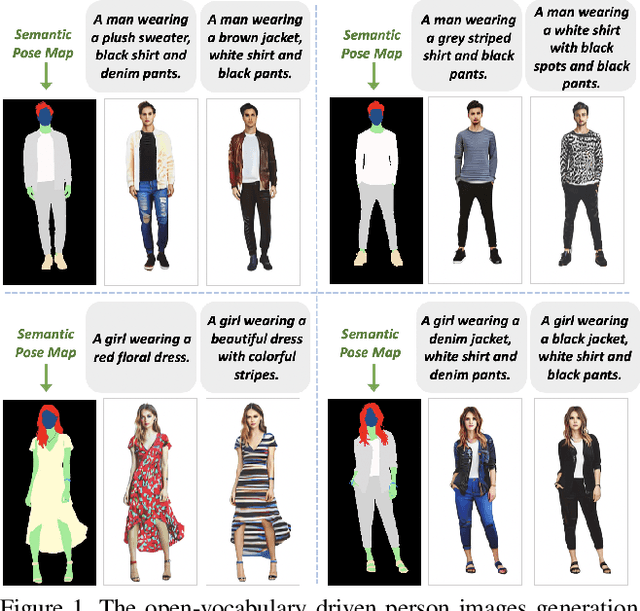
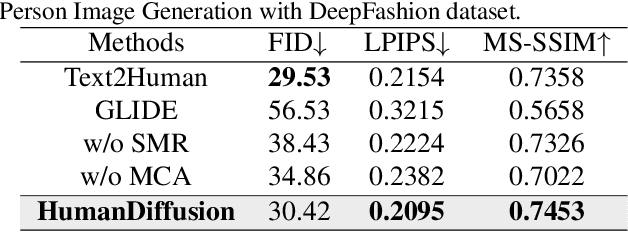
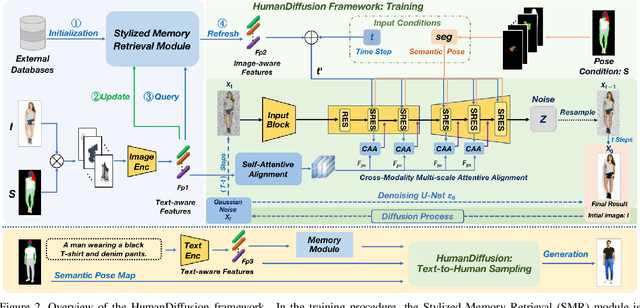

Abstract:Text-driven person image generation is an emerging and challenging task in cross-modality image generation. Controllable person image generation promotes a wide range of applications such as digital human interaction and virtual try-on. However, previous methods mostly employ single-modality information as the prior condition (e.g. pose-guided person image generation), or utilize the preset words for text-driven human synthesis. Introducing a sentence composed of free words with an editable semantic pose map to describe person appearance is a more user-friendly way. In this paper, we propose HumanDiffusion, a coarse-to-fine alignment diffusion framework, for text-driven person image generation. Specifically, two collaborative modules are proposed, the Stylized Memory Retrieval (SMR) module for fine-grained feature distillation in data processing and the Multi-scale Cross-modality Alignment (MCA) module for coarse-to-fine feature alignment in diffusion. These two modules guarantee the alignment quality of the text and image, from image-level to feature-level, from low-resolution to high-resolution. As a result, HumanDiffusion realizes open-vocabulary person image generation with desired semantic poses. Extensive experiments conducted on DeepFashion demonstrate the superiority of our method compared with previous approaches. Moreover, better results could be obtained for complicated person images with various details and uncommon poses.
LightVessel: Exploring Lightweight Coronary Artery Vessel Segmentation via Similarity Knowledge Distillation
Nov 02, 2022Abstract:In recent years, deep convolution neural networks (DCNNs) have achieved great prospects in coronary artery vessel segmentation. However, it is difficult to deploy complicated models in clinical scenarios since high-performance approaches have excessive parameters and high computation costs. To tackle this problem, we propose \textbf{LightVessel}, a Similarity Knowledge Distillation Framework, for lightweight coronary artery vessel segmentation. Primarily, we propose a Feature-wise Similarity Distillation (FSD) module for semantic-shift modeling. Specifically, we calculate the feature similarity between the symmetric layers from the encoder and decoder. Then the similarity is transferred as knowledge from a cumbersome teacher network to a non-trained lightweight student network. Meanwhile, for encouraging the student model to learn more pixel-wise semantic information, we introduce the Adversarial Similarity Distillation (ASD) module. Concretely, the ASD module aims to construct the spatial adversarial correlation between the annotation and prediction from the teacher and student models, respectively. Through the ASD module, the student model obtains fined-grained subtle edge segmented results of the coronary artery vessel. Extensive experiments conducted on Clinical Coronary Artery Vessel Dataset demonstrate that LightVessel outperforms various knowledge distillation counterparts.
Robust and Efficient Segmentation of Cross-domain Medical Images
Jul 26, 2022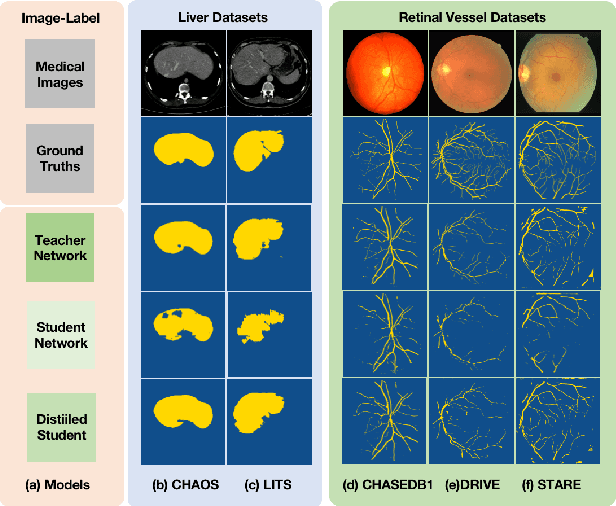
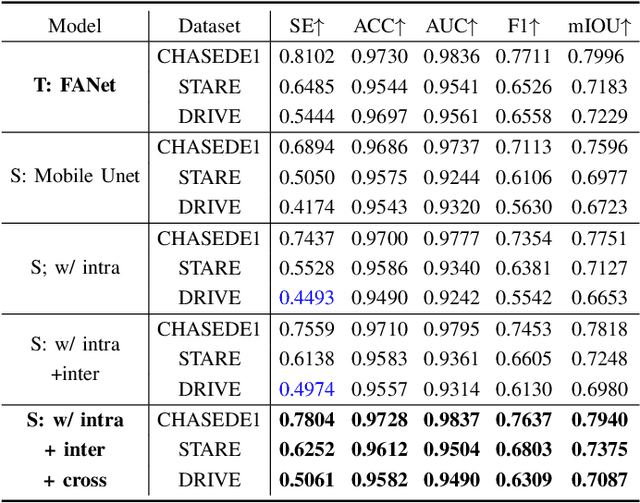
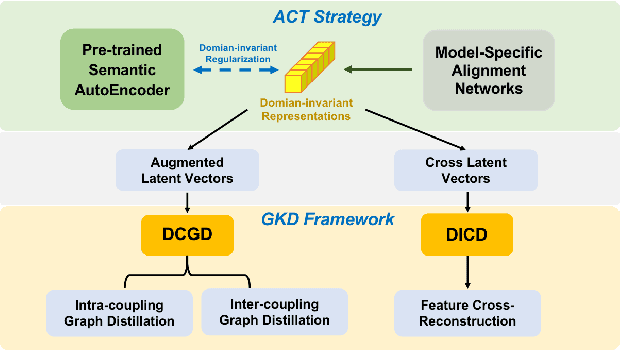
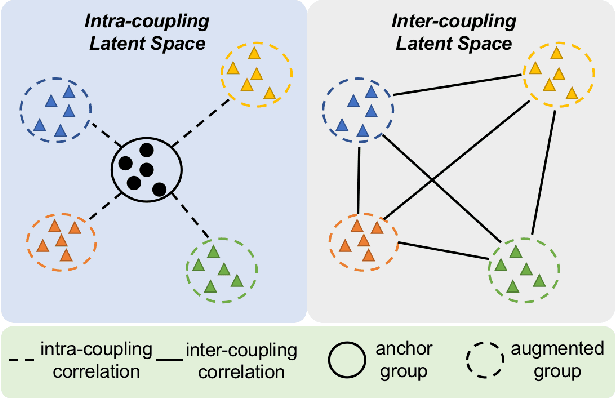
Abstract:Efficient medical image segmentation aims to provide accurate pixel-wise prediction for the medical images with the lightweight implementation framework. However, lightweight frameworks generally fail to achieve high performance, and suffer from the poor generalizable ability on cross-domain tasks.In this paper, we propose a generalizable knowledge distillation method for robust and efficient segmentation of cross-domain medical images. Primarily, we propose the Model-Specific Alignment Networks (MSAN) to provide the domain-invariant representations which are regularized by a Pre-trained Semantic AutoEncoder (P-SAE). Meanwhile, a customized Alignment Consistency Training (ACT) strategy is designed to promote the MSAN training. With the domain-invariant representative vectors in MSAN, we propose two generalizable knowledge distillation schemes, Dual Contrastive Graph Distillation (DCGD) and Domain-Invariant Cross Distillation (DICD). Specifically, in DCGD, two types of implicit contrastive graphs are designed to represent the intra-coupling and inter-coupling semantic correlations from the perspective of data distribution. In DICD, the domain-invariant semantic vectors from the two models (i.e., teacher and student) are leveraged to cross-reconstruct features by the header exchange of MSAN, which achieves generalizable improvement for both the encoder and decoder in the student model. Furthermore, a metric named Fr\'echet Semantic Distance (FSD) is tailored to verify the effectiveness of the regularized domain-invariant features. Extensive experiments conducted on the Liver and Retinal Vessel Segmentation datasets demonstrate the priority of our method, in terms of performance and generalization on lightweight frameworks.
ShowFace: Coordinated Face Inpainting with Memory-Disentangled Refinement Networks
Apr 16, 2022


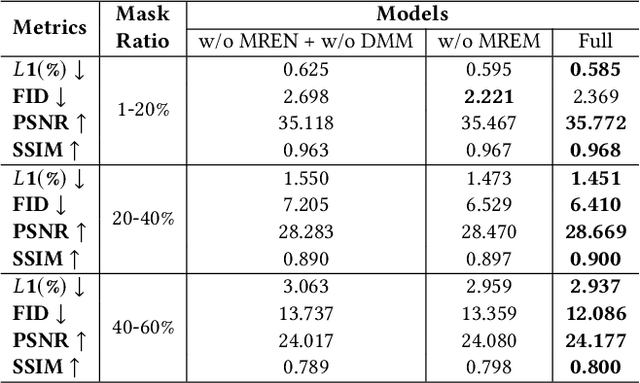
Abstract:Face inpainting aims to complete the corrupted regions of the face images, which requires coordination between the completed areas and the non-corrupted areas. Recently, memory-oriented methods illustrate great prospects in the generation related tasks by introducing an external memory module to improve image coordination. However, such methods still have limitations in restoring the consistency and continuity for specificfacial semantic parts. In this paper, we propose the coarse-to-fine Memory-Disentangled Refinement Networks (MDRNets) for coordinated face inpainting, in which two collaborative modules are integrated, Disentangled Memory Module (DMM) and Mask-Region Enhanced Module (MREM). Specifically, the DMM establishes a group of disentangled memory blocks to store the semantic-decoupled face representations, which could provide the most relevant information to refine the semantic-level coordination. The MREM involves a masked correlation mining mechanism to enhance the feature relationships into the corrupted regions, which could also make up for the correlation loss caused by memory disentanglement. Furthermore, to better improve the inter-coordination between the corrupted and non-corrupted regions and enhance the intra-coordination in corrupted regions, we design InCo2 Loss, a pair of similarity based losses to constrain the feature consistency. Eventually, extensive experiments conducted on CelebA-HQ and FFHQ datasets demonstrate the superiority of our MDRNets compared with previous State-Of-The-Art methods.
 Add to Chrome
Add to Chrome Add to Firefox
Add to Firefox Add to Edge
Add to Edge